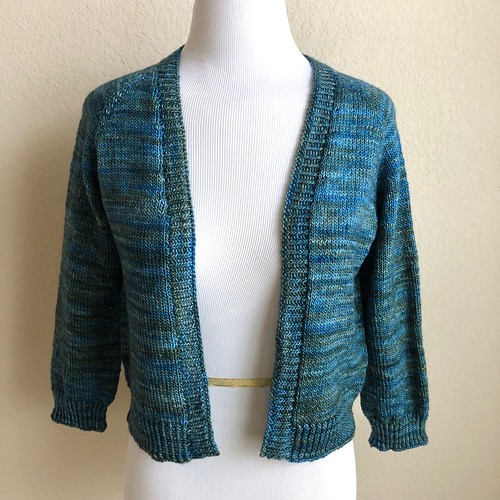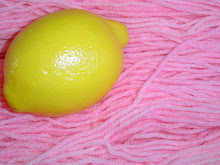A Finished Cardigan
This is the Aki Cardigan. The designer, Ambah O'Brien, is the featured designer for the First Quarter ESK Knit-Along. I thought it was a great little cardigan and it's the kind of thing that's perfect to toss on with jeans and a cute top. The pattern is written for two strands of laceweight weight yarn, but notes that you could also use fingering, so I grabbed some Madelinetosh Tosh Merino Light in Worn Denim that had been carefully preserved in my stash since the color was discontinued, and started knitting.
When I got to the point where the sleeve stitches are separated from the body stitches, I knew I had a problem. Since the pattern was written for two strands of laceweight, the gauge was figured for two strands of laceweight. If you substitute fingering weight, you can easily get stitch gauge, but you probably won't be getting row gauge, which is a very important part of top down raglan shaped sweaters. Two strands of laceweight is lighter (weight wise) than fingering weight, even when knit at the same stitch gauge. Also, singles are denser and heavier than plied yarns even when they're the same size finished yarn. What this meant was that even though my stitches per inch was exactly right, because of the weight of the yarn, I had far fewer rows per inch. My yoke was way too deep and since nobody wants saggy armpits, I had to frog. Fortunately, because of the high number of rows per inch the pattern calls for, there are some plain, non-increase rounds built into the raglan shaping. When I restarted, I did some math (gasp, faint) and figured out that things would be pretty much back on track if I eliminated these rounds. I double checked these maths against the shaping of the Ravello pullover (which is also raglan shaping and is designed for fingering weight) and soon I was moving forward again. Measuring carefully as I went this time.
Once I'd gotten things figured out, the sweater moved along very quickly. I would like to note that this is not a complaint about the pattern - the pattern is written correctly as long as you knit with two strands of laceweight, as it's written. The problem I encountered was due to the change in yarn weight which due to knitting physics caused more changes to the pattern than I originally planned for. But in the end, I survived, I have a cute cardigan and if I ever knit this pattern again, I'll follow the directions and use two strands of laceweight!
When I got to the point where the sleeve stitches are separated from the body stitches, I knew I had a problem. Since the pattern was written for two strands of laceweight, the gauge was figured for two strands of laceweight. If you substitute fingering weight, you can easily get stitch gauge, but you probably won't be getting row gauge, which is a very important part of top down raglan shaped sweaters. Two strands of laceweight is lighter (weight wise) than fingering weight, even when knit at the same stitch gauge. Also, singles are denser and heavier than plied yarns even when they're the same size finished yarn. What this meant was that even though my stitches per inch was exactly right, because of the weight of the yarn, I had far fewer rows per inch. My yoke was way too deep and since nobody wants saggy armpits, I had to frog. Fortunately, because of the high number of rows per inch the pattern calls for, there are some plain, non-increase rounds built into the raglan shaping. When I restarted, I did some math (gasp, faint) and figured out that things would be pretty much back on track if I eliminated these rounds. I double checked these maths against the shaping of the Ravello pullover (which is also raglan shaping and is designed for fingering weight) and soon I was moving forward again. Measuring carefully as I went this time.
Once I'd gotten things figured out, the sweater moved along very quickly. I would like to note that this is not a complaint about the pattern - the pattern is written correctly as long as you knit with two strands of laceweight, as it's written. The problem I encountered was due to the change in yarn weight which due to knitting physics caused more changes to the pattern than I originally planned for. But in the end, I survived, I have a cute cardigan and if I ever knit this pattern again, I'll follow the directions and use two strands of laceweight!
Labels: Cardigans











0 Comments:
Post a Comment
<< Home